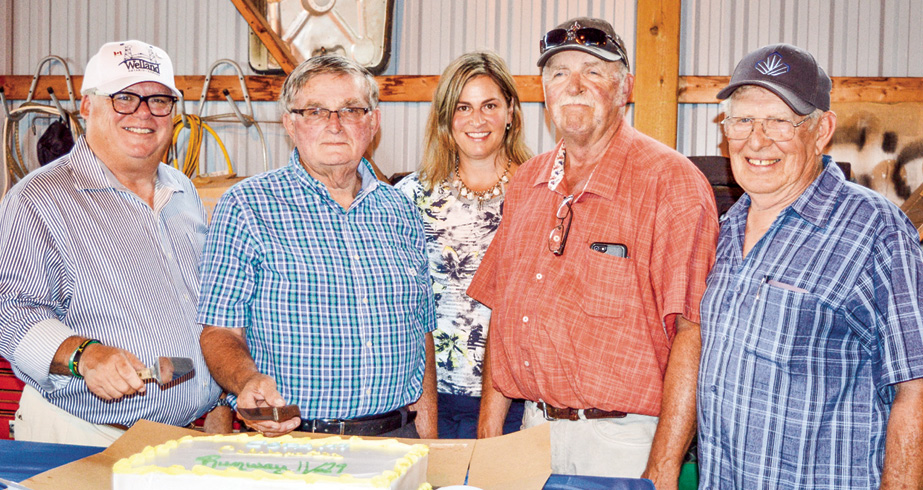BY GLORIA J. KATCH Special to the VOICE
“Everybody’s happy. It’s a win-win situation,” Adrian Verburg, Captain of the Canadian Owners and Pilots Association (COPA) told the Voice, after the organization restored a piece of local history to a new and improved level. COPA recently completed a 2,500 ft. strip of runway, known as 11/29, at the Niagara Central Dorothy Rungeling Airport, which was officially opened during a plaque dedication ceremony and barbecue last Wednesday.
The airport’s navigation capabilities are “now back to it’s original triangle configuration,” noted Verburg, who educated many dignitaries, COPA volunteers and “friends of the airport,” who were in attendance for a slide presentation, which referred back to the airport’s construction in 1942.
The grass turf surface now has a durable base layered with old broken asphalt and gravel, so water will not pool on it, providing ample drainage, explained Verburg.
The runway adds an additional safety feature to the airport and is now easier to maintain and cheaper than asphalt, which would have cost $250,000 to replace, he said.
The grass surface also attracts many aviation schools to the site, as grass is “a part of the syllabus of emergency training,” as all pilots have to learn how to land on grass, a procedure known as a “soft-field landing.”
If an airplane’s engine cuts out in flight, chances are the pilot will be landing in a field—and, often times, not a spacious field, explained Verburg. Since runway 11/29 became operational on June 2, there have already been several training sessions held there from various aviation schools. (See the video at the end of this story for a classic example of a soft field landing emergency at Los Angeles International Airport.)
The airstrip was also in running order for the 2019 Air Race Classic, held June 21-22, which hosted some 100 contestants.
(Runways are named for the compass directions they face. Since almost all runways may be used in both directions, they are labelled with two compass headings. In this case, 110 degrees—slightly south of due east—and 290 degrees—slightly north of due west. For efficiency, only the first two numerals are used to identify runways on navigation charts—hence, “11/29”—and only the takeoff or landing direction is specified in radio communications—for example, “Cleared to land runway two-niner.”)
The airport was originally built in a large, triangular design as a part of the British Training Plan used for World War II military aviation exercises. However, the largest cost in airport maintenance is in the care of asphalt runways, and 11/29 eventually deteriorated to the point that it could not be safely used about 30 years ago.
However, in 2007, following the development of a roadway by the airport commission behind several hangars, Verburg said COPA thought it would be beneficial to partner with the commission and restore the landing strip.
In just over a year, COPA fundraised and invested about $12,000 for the runway, and many of its volunteers who are pilots did a great deal of the work to restore it, he said. COPA has an agreement with the local airport commission to maintain 11/29, as well. Verburg believes the runway will cost about $1,500 a year to maintain. Equipment has been provided to keep the runway operational for 10 months out of the year, he said.
“The amazing thing is that it was all done with donations, many of them from COPA members themselves, and not a penny of taxpayers’ money,” he said.
COPA’s next project is to refurbish an old pump-house into a storage area for the equipment on site needed to maintain the runway. The airport commission will fund the cost of the materials, which Verburg estimates at approximately $7,500, and COPA volunteers will be doing the refurbishing and labour. He also thanked “good neighbours,” like Joyce and John Sonneveld, who lease land surrounding the airport for their business, River Bend Farms, and assist by lending equipment and supporting projects like these.
“It takes a unique group that has gone to the extent it has to support and promote this airport, and you don’t get that everywhere,” said Verburg.
While many of the 47 registered members of the local chapter are, “not kids anymore, we have lots of expertise in using equipment and saws.”
While Verburg and many members are retired, they do support education and encourage the next generation in aviation through many COPA for Kids programs, including an upcoming seminar, on August 17, which allows youths from eight to 17 free rides at the airport. Visit www.centralairport.ca for more information.
COPA has some 200 chapters in Canada, with about 40 in Ontario alone. Branch 149 meets monthly, and has barbecues about four times a year, Verburg noted. The association organizes fundraisers and accepts donations for the various aviation-related projects it undertakes.



